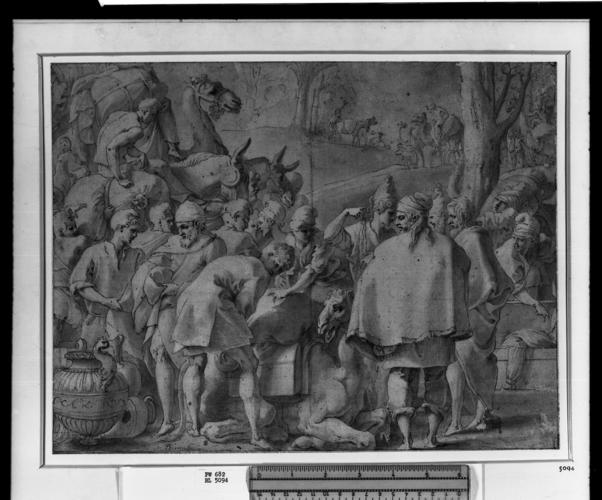Joseph sold by his brothers to the Ishmaelite merchants(?) c.1541-46
Pen and ink and pale red wash with white heightening, over black and red chalk underdrawing; traces of light squaring in black chalk, the outlines indented with a stylus | 29.3 x 38.4 cm (sheet of paper) | RCIN 905094
-
A drawing of a group of men gathered around a setaed camel laden with baggage; other figures with camels and mules in the distance.
This drawing and another in the Louvre (depicting the Forge of Vulcan, inv. 8533) can be connected with a pair of paintings for the chimney breast of the Cabinet du Roi at Fontainebleau, executed as part of a campaign of decoration by Primaticcio between 1541 and 1546. The paintings, unusually on panel rather than in fresco, were recorded in inventories of 1642 and 1709-10, but were removed in 1713 and are now lost. The companion to the Forge of Vulcan was in the earliest inventory described as ‘Joseph, as his brothers came to visit him in Egypt’. It has been suggested that the episode depicted was the search of the baggage of Joseph’s brothers after he had sent them back to their father with sacks of corn, in one of which was planted a silver cup. A more explicit depiction of searching or discovery might however have been expected - only the figure at far right opens any of the baggage, and the ornate vase standing at lower left, to which no one pays any attention, is unlikely to have been the hidden cup.
This may in fact be the sale of Joseph by his brothers to the merchants. Some sort of transaction is taking place: the youth to the right of centre holds a chain as if evaluating its weight, and the bearded man at centre left feels around inside his cloak for a purse. The coffer at far right, being opened by one of the youths, seems to give forth a trousered leg, presumably that of the bound Joseph. The two paintings would be an odd pair, one from mythology, the other from the Old Testament, and while the forge of Vulcan was a common subject for chimney paintings, the relationship between the two subjects remains obscure.
This drawing is executed with more meticulous wash and less red chalk than the Forge of Vulcan, and its attribution has been the subject of some debate. The crispness of the details and the quality of modelling favour an attribution to Primaticcio himself, though the function of the drawing is not entirely certain, and a vigorous study in red chalk alone for the figure group, in the Uffizi, does not help to resolve the issue. The figures correspond exactly with those in two prints of the school of Fontainebleau: one in reverse signed with the initials of Leon Davent and lettered 'Bol inventeur a Fonteinebleau' (Primaticcio was known as ‘Bolognese’ from his place of birth); the other anonymous, in the same sense as the drawing, and probably copied from the first print, adding a different background [Bartsch XVI, p. 331, no. 63 and p. 412, no. 92].
Like many compositional drawings by Primaticcio, the outlines of the figures were indented with a stylus to transfer the composition directly to the copper plate or to an intermediate drawing for the use of the etcher or engraver. But there are also light traces of squaring in black chalk here, most visible in the cloak of the dominant man at centre right, possibly indicating that the composition was to be scaled up to the size of the painting. The drawing may thus have served several purposes: a modello for the approval of the patron (hence its painstaking level of finish), a working study for the painting, and thereafter a model for the printmaker to follow.
See M. Clayton,The Art of Italy in the Royal Collection: Renaissance and Baroque, London, 2007, no. 43.Provenance
From one of four albums listed in George III's Inventory A, c.1800, p. 16, Diversi Maestri Antichi.
-
Creator(s)
-
Medium and techniques
Pen and ink and pale red wash with white heightening, over black and red chalk underdrawing; traces of light squaring in black chalk, the outlines indented with a stylus
Measurements
29.3 x 38.4 cm (sheet of paper)
Object type(s)
Other number(s)











